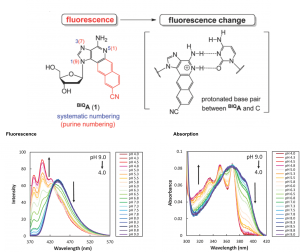The ubiquity of radioisotope-based bioprobes is being challenged by their nonradioactive counterparts. In recent years, they have gained significant popularity in life sciences due to major advances in available detection methods and enhanced analytical performance. Many would argue that radioactive labels offer superior results in experiments that require high sensitivity and resolution but their safe handling, stability and the proper disposal of radioactive materials limit speed and convenience of use.
The newest generation of fluorescent and chemifluorescent probes promise greater flexibility and versatility for a range of applications and the development of fully automated instrumentations and powerful imaging systems provide high throughput solutions to meet the increasing demands of the modern lab.
|
|
Unique photophysical properties can be incorporated into small biomolecules to generate fluorescent bioprobes. Fluorescently labeled nucleosides have distinct advantages over other synthetic molecules due to inherent fluorescence and minimal steric disruptions, and they can be tuned e.g. to form unusual base-pair preferences. They form noncovalent, highly specific duplexes with a complementary nucleic acid strand and are used to detect a defined DNA or RNA target sequence.
In a recent publication from the group of Yoshio Saito of Nihon University, the development of a novel nucleoside-based bioprobe containing a 3-deaza-2’-deoxyadenosine skeleton was reported. It behaves as an indicator for adenosine-cytosine base pair formation in oligodeoxynucleotide (ODN) duplexes by monitoring base-pair induced protonation. The probe displays distinct changes in its absorption and fluorescence activity as a result of its protonation state. In this way, the group is able to clearly discriminate cytosine from other bases on complementary strands based on absorption and fluorescence spectra.
The development of new biomarkers is providing insight to various genetic disorders, disease susceptibility, cancer predisposition and medication response. When fluorescent bioprobe imaging is coupled with genetic analytical techniques, such as single nucleoside polymorphism (SNP)-typing, the two synergize and provide a much more complete view than either one alone.
To find out more see:
Design and synthesis of a novel fluorescent benzo[g]imidazo[4,5-c]quinoline nucleoside for monitoring base-pair-induced protonation with cytosine: distinguishing cytosine via changes in the intensity and wavelength of fluorescence
Shogo Siraiwa, Azusa Suzuki, Ryuzi Katoh and Yoshio Saito
DOI:10.1039/C6OB00494F
Victoria Corless is currently completing her Ph.D. in organic chemistry with Prof. Andrei Yudin at The University of Toronto. Her research is centred on the synthesis of kinetically amphoteric molecules, which offer a versatile platform for the development of chemoselective transformations with particular emphasis on creating novel biologically active molecules.











